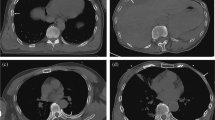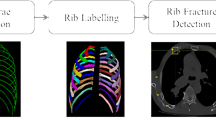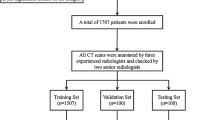Abstract
Objectives
To evaluate deep neural networks for automatic rib fracture detection on thoracic CT scans and to compare its performance with that of attending-level radiologists using a large amount of datasets from multiple medical institutions.
Methods
In this retrospective study, an internal dataset of 12,208 emergency room (ER) trauma patients and an external dataset of 1613 ER trauma patients taking chest CT scans were recruited. Two cascaded deep neural networks based on an extended U-Net architecture were developed to segment ribs and detect rib fractures respectively. Model performance was evaluated with a 95% confidence interval (CI) on both the internal and external dataset, and compared with attending-level radiologist readings using t test.
Results
On the internal dataset, the AUC of the model for detecting fractures at per-rib level was 0.970 (95% CI: 0.968, 0.972) with sensitivity of 93.3% (95% CI: 92.0%, 94.4%) at a specificity of 98.4% (95% CI: 98.3%, 98.5%). On the external dataset, the model obtained an AUC of 0.943 (95% CI: 0.941, 0.945) with sensitivity of 86.2% (95% CI: 85.0%, 87.3%) at a specificity of 98.8% (95% CI: 98.7%, 98.9%), compared to the sensitivity of 70.5% (95% CI: 69.3%, 71.8%) (p < .0001) and specificity of 98.8% (95% CI: 98.7%, 98.9%) (p = 0.175) by attending radiologists.
Conclusions
The proposed DL model is a feasible approach to identify rib fractures on chest CT scans, at the very least, reaching a level on par with attending-level radiologists.
Key Points
• Deep learning–based algorithms automatically detected rib fractures with high sensitivity and reasonable specificity on chest CT scans.
• The performance of deep learning–based algorithms reached comparable diagnostic measures with attending level radiologists for rib fracture detection on chest CT scans.
• The deep learning models, similar to human readers, were susceptible to the inconspicuity and ambiguity of target lesions. More training data was required for subtle lesions to achieve comparable detection performance.





Similar content being viewed by others
Abbreviations
- AUC:
-
Area under the receiver operating characteristics curve
- CI:
-
Confidence interval
- CT:
-
Computed tomography
- DL:
-
Deep learning
- EDD:
-
External development dataset
- ER:
-
Emergency room
- EVD:
-
External verification dataset
- FPPS:
-
False positives per scan
- FROC:
-
Free-response receiver operating characteristic curve
- IoU:
-
Intersection over union
- IVD:
-
Internal verification dataset
- MPR:
-
Multiplanar reconstruction
- PACS:
-
Picture archiving and communication system
References
Sirmali M, Türüt H, Topçu S et al (2003) A comprehensive analysis of traumatic rib fractures: morbidity, mortality and management. Eur J Cardiothorac Surg 24:133–138
Talbot BS, Gange CP Jr, Chaturvedi A, Klionsky N, Hobbs SK, Chaturvedi A (2017) Traumatic rib injury: patterns, imaging pitfalls, complications, and treatment. Radiographics 37:628–651
Ziegler DW, Agarwal NN (1994) The morbidity and mortality of rib fractures. J Trauma 37:975–979
Marini CP, Petrone P, Soto-Sánchez A, García-Santos E, Stoller C, Verde J (2021) Predictors of mortality in patients with rib fractures. Eur J Trauma Emerg Surg 47:1527–1534
Brasel KJ, Moore EE, Albrecht RA et al (2017) Western Trauma Association Critical Decisions in Trauma: management of rib fractures. J Trauma Acute Care Surg 82:200–203
Lee RB, Bass SM, Morris JA Jr, MacKenzie EJ (1990) Three or more rib fractures as an indicator for transfer to a Level I trauma center: a population-based study. J Trauma 30:689–694
Karlson KA, French A, Moreira ME (2016) Initial evaluation and management of rib fractures. UpToDate. https://www.uptodate.com/contents/initial-evaluation-andmanagement-of-rib-fractures
Chung JH, Cox CW, Mohammed TL et al (2014) ACR appropriateness criteria blunt chest trauma. J Am Coll Radiol 11:345–351
Henry TS, Kirsch J, Kanne JP et al (2014) ACR Appropriateness Criteria® rib fractures. J Thorac Imaging 29:364–366
Cho SH, Sung YM, Kim MS (2012) Missed rib fractures on evaluation of initial chest CT for trauma patients: pattern analysis and diagnostic value of coronal multiplanar reconstruction images with multidetector row CT. Br J Radiol 85:e845–e850
Ringl H, Lazar M, Töpker M et al (2015) The ribs unfolded - a CT visualization algorithm for fast detection of rib fractures: effect on sensitivity and specificity in trauma patients. Eur Radiol 25:1865–1874
Livingston DH, Shogan B, John P, Lavery RF (2008) CT diagnosis of Rib fractures and the prediction of acute respiratory failure. J Trauma 64:905–911
Jin L, Yang J, Kuang K et al (2020) Deep-learning-assisted detection and segmentation of rib fractures from CT scans: development and validation of FracNet. EBioMedicine 62:103106
Zhou QQ, Wang J, Tang W et al (2020) automatic detection and classification of rib fractures on thoracic CT using convolutional neural network: accuracy and feasibility. Korean J Radiol 21:869–879
Zhang B, Jia C, Wu R et al (2021) Improving rib fracture detection accuracy and reading efficiency with deep learning-based detection software: a clinical evaluation. Br J Radiol 94:20200870
Weikert T, Noordtzij LA, Bremerich J et al (2020) Assessment of a deep learning algorithm for the detection of rib fractures on whole-body trauma computed tomography. Korean J Radiol 21:891–899
Bemelman M, Baal MV, Raaijmakers C, Lansink K, Leenen L, Long W (2019) An interobserver agreement study with a new classification for rib fractures. Chirurgia (Bucur) 114:352–358
Ronneberger O, Fischer P, Brox T (2015) U-Net: Convolutional networks for biomedical image segmentation. In: Navab N, Hornegger J, Wells WM, Frangi AF (eds) Medical Image Computing and Computer-Assisted Intervention – MICCAI 2015. Springer International Publishing, Cham, pp 234–241
Hwang J, Hanowell LH, Grande CM (1996) 7 Peri-operative concerns in thoracic trauma. Baillieres Clin Anaesthesiol 10:123-153
Funding
This study received funding by National Natural Science Foundation of China ( No.8225024) and Shanghai Municipal Education Commission-Gaofeng Clinical Medicine Grant Support (No.2016427).
Author information
Authors and Affiliations
Corresponding author
Ethics declarations
Guarantor
The scientific guarantor of this publication is Yuehua Li.
Conflict of interest
The authors of this manuscript declare relationships with any companies whose products or services may be related to the subject matter of the article.
Statistics and biometry
No complex statistical methods were necessary for this paper.
Informed consent
Because the patient data were deidentified, the IRB waived the signed informed consent of all patients whose data were included in this study.
Ethical approval
The study protocol was approved by the institutional review board (IRB) of our hospital.
Methodology
• retrospective
• diagnostic study
• multicenter study
Additional information
Publisher’s note
Springer Nature remains neutral with regard to jurisdictional claims in published maps and institutional affiliations.
Shuhao Wang and Dijia Wu contributed to this manuscript equally.
Supplementary Information
ESM 1
(DOCX 29 kb)
Rights and permissions
Springer Nature or its licensor holds exclusive rights to this article under a publishing agreement with the author(s) or other rightsholder(s); author self-archiving of the accepted manuscript version of this article is solely governed by the terms of such publishing agreement and applicable law.
About this article
Cite this article
Wang, S., Wu, D., Ye, L. et al. Assessment of automatic rib fracture detection on chest CT using a deep learning algorithm. Eur Radiol 33, 1824–1834 (2023). https://doi.org/10.1007/s00330-022-09156-w
Received:
Revised:
Accepted:
Published:
Issue Date:
DOI: https://doi.org/10.1007/s00330-022-09156-w




